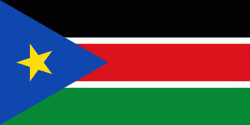Flag of South Sudan
The flag of South Sudan was adopted following the signing of the Comprehensive Peace Agreement that ended the Second Sudanese Civil War. A similar version of the flag was previously used as the flag of the Sudan People's Liberation Movement. The flag of South Sudan is older than the country itself, as the flag was adopted in 2005, while the country became independent in 2011.
When Sudan became independent in 1956, the predominantly Christian people living in the south of the country had no regional symbols, while the already dominant Muslim north displayed Islamic symbols on the national flag. Before independence, the British government had arranged for appropriate local symbols for the regions in Sudan, but the new government in independent Sudan had opposed the use of these symbols as being counterproductive to fostering national unity.
From the outset, the southern Sudanese felt discriminated against by the Islamic north. The southerners fought a drawn-out and bloody civil war to gain their independence, followed by a peace agreement in 2005 that included a referendum on independence in the south. The referendum was passed with overwhelming support in 2011, and South Sudan became officially independent on 9 July that same year. In the 1990s, during their struggle with the north, the southern Sudanese had created a banner of independence, which would become the new national flag. The flag was designed by Samuel Ajak, who was an artist and brigadier general for the Sudan People's Liberation Army under revolutionary leader John Garang.
When Sudan became independent in 1956, the predominantly Christian people living in the south of the country had no regional symbols, while the already dominant Muslim north displayed Islamic symbols on the national flag. Before independence, the British government had arranged for appropriate local symbols for the regions in Sudan, but the new government in independent Sudan had opposed the use of these symbols as being counterproductive to fostering national unity.
From the outset, the southern Sudanese felt discriminated against by the Islamic north. The southerners fought a drawn-out and bloody civil war to gain their independence, followed by a peace agreement in 2005 that included a referendum on independence in the south. The referendum was passed with overwhelming support in 2011, and South Sudan became officially independent on 9 July that same year. In the 1990s, during their struggle with the north, the southern Sudanese had created a banner of independence, which would become the new national flag. The flag was designed by Samuel Ajak, who was an artist and brigadier general for the Sudan People's Liberation Army under revolutionary leader John Garang.
National flag
Country - South_Sudan
Warning: getimagesize(/Image/Map/MP7909807.gif): failed to open stream: No such file or directory in /home/mapnlee7/public_html/MAPNALL/article.php on line 532
 |
 |
South Sudan gained independence from Sudan on 9 July 2011, making it the most recent sovereign state or country with widespread recognition as of 2023. It includes the vast swamp region of the Sudd, formed by the White Nile and known locally as the Bahr al Jabal, meaning "Mountain River". Sudan was occupied by Egypt under the Muhammad Ali dynasty and was governed as an Anglo-Egyptian condominium until Sudanese independence in 1956. Following the First Sudanese Civil War, the Southern Sudan Autonomous Region was formed in 1972 and lasted until 1983. A second Sudanese civil war soon broke out in 1983 and ended in 2005 with the Comprehensive Peace Agreement. Later that year, southern autonomy was restored when an Autonomous Government of Southern Sudan was formed. South Sudan became an independent state on 9 July 2011, following 98.83% support for independence in a January 2011 referendum. It has suffered ethnic violence and endured a civil war characterized by rampant human rights abuses, including various ethnic massacres and killings of journalists by various parties to the conflict from December 2013 until February 2020, when competing combat leaders Salva Kiir Mayardit and Riek Machar struck a unity deal and formed a coalition government, paving the way for refugees to return home.
